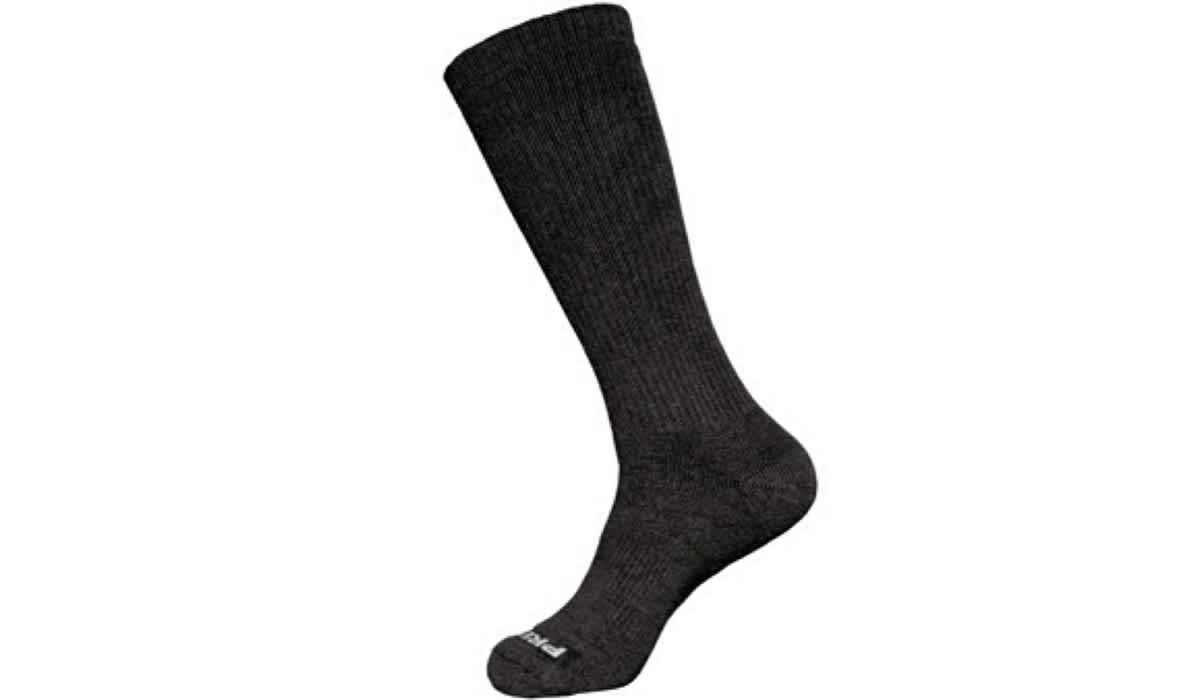Trekking with the Best Hiking Socks

1. Altera Alpaca Prevail Medium Weight – Editor’s Pick
Alpaca fleece is seriously smooth and seriously soft. From a pure comfort standpoint, even for a hiking sock, it borders on luxurious. Face it, even the roughest, toughest most hardcore among us enjoys comfortable clothing. Altera ticks that box. Aside from the smooth exterior of alpaca fleece, it also has a hollow core. This hollow core serves two purposes. First, it aids in wicking moisture away naturally. Second, it helps with thermal regulation. Properly regulated temperatures paired with natural wicking help keep feet dry, and a dry foot doesn’t stink. Add in the silver infusion technology and you have a hiking sock you will have to work to make stink. Did I mention they’re comfortable?
2. Smartwool Hike Classic Light Cushion – Reliable Pick
Some things just work. It’s been more than 25 years since Smartwool invented the original Merino wool performance sock, and not much has changed since it was introduced. The modern version uses more recycled nylon than the original did, but who can’t get behind some creative recycling? Look at most performance hiking socks, squint a little bit, and you see a lot of the same elements that Smartwool introduced back then. Sure, it’s a sock, how exotic can you get with design? But when the Classic Hike came out, it was something new. You can still trust these socks to keep your feet comfortable, protected, and putting one foot in front of the other all day thanks to the elasticized arch brace and flat knit toe.
3. Darn Tough Hiker Boot Midweight – Long-Term Pick
If you’ve not heard of Darn Tough socks, I’m sorry, because these things are next-level. They feature the highest percentage of Merino wool on the list, to go with the nylon, and lycra that make for a snug, performance fit. That fit is critical, because the lack of slipping or bunching is what helps prevent blisters. They boast all the benefits you would expect from a Merino wool sock, like the wicking and the thermal control, but where Darn Tough stands out is in their guarantee. Yes, guarantee. These things are guaranteed for life. Look it up. I didn’t believe it at first either, but it’s true. To stand behind a sock like that, says a lot. These things are worth a look.
4. Wrightsock Adventure Crew Hiking – Anti-Blister Pick
Wrightsock has a whole lineup of purpose-designed socks for all kinds of applications, and their hiking offering reflects their commitment to innovative and functional product. Wrightsock hiking socks are a poly/nylon/lycra blend, so you have a performance fit that will functionally wick moisture to keep your feet comfortable during long days on the trail. The mesh panel improves breathability, and the Stabilizer Zone keeps the socks locked in place even when hiking in awkward conditions. A key benefit of a good hiking sock is blister prevention, and Wrightsock guarantees no blisters. Yes, blister-free socks.
5. Columbia Hike Merino Medium Crew – Budget Pick
All-day comfort and all-day performance without breaking the bank. The Columbia brand is synonymous without outdoor recreation, so it makes all the sense in the world that they deliver a no-nonsense hiking sock that gives you everything you need at a reasonable price. Like most performance hiking socks they’re constructed with a blend of Merino wool, nylon, poly, and spandex. The shield block ankle is a great little benefit to help protect the ankle at a common pinch point.
Picking the right hiking socks
There are a lot of factors that go into the right hiking sock for the application, but three good ones to start with are height, cushioning, and fit. Choose a height that gets above the top of the upper of the boot to keep them from irritating your shins or ankles. Cushioning affects comfort, of course, but also plays into thermal protection. You won’t want to hike in the same socks in July as you would in December. Lastly, make sure the socks fit properly. If the heel pocket is halfway up the back of your ankle, you won’t get the maximum comfort or protection.
What is Merino wool?
You’ll see many of the better hiking socks use Merino wool as the main material. It might seem obvious, but Merino wool comes from Merino sheep. Unlike traditional wool, Merino wool is fine fibered and soft, so it’s not itchy like traditional wool either. It’s also more flexible, making it a more comfortable material overall. It’s also naturally odor-resistant, moisture-wicking, and breathable. No wonder it’s so sought after as a material for hiking socks! There are synthetic fibers that are still trying to catch up to the fiber Merino sheep have been generating for a handful of centuries.
How tight should hiking socks be?
You’ll want to avoid excess material in your hiking socks because it can cause blistering and discomfort in your hiking boots. Try for a fit that is snug, but still fits your foot correctly.
How thick should hiking socks be?
Ultimately, you want to base your hiking sock thickness on the weather. This socks for warm days and go thicker as the temperature drops. Keep sizing in mind as well as how your boots fit, too.
Why can't I just wear normal cotton socks?
Cotton socks are a poor choice for hiking for two reasons. One, cotton absorbs moisture, so the sweat from your foot will soak in and stay next to your skin. Secondly, it is a heavier fabric, so it will promote sweating, even on cooler days.
We are committed to finding, researching, and recommending the best products. We earn commissions from purchases you make using the retail links in our product reviews. Learn more about how this works.











